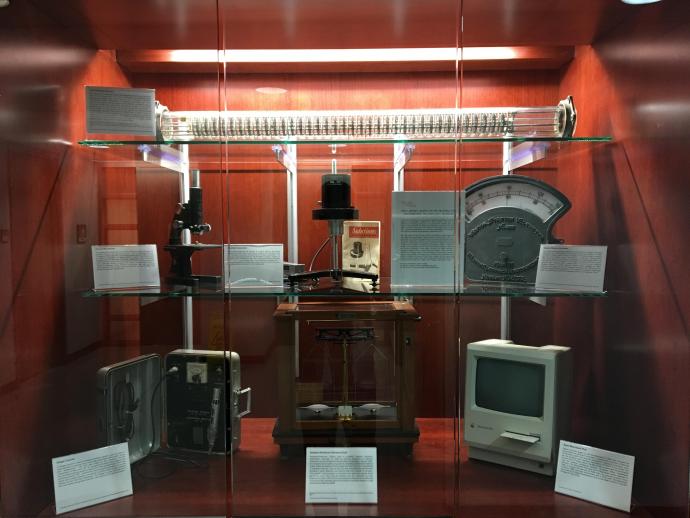NJIT Showcases History of Science and Engineering with 'Distributed Technology Museum'
On the third floor of Fenster Hall, visitors can find a rich collection of landmark science and engineering artifacts that resemble a technological time capsule of the past 100 years. The iconic 1984 Apple Macintosh Plus, a 1950s suitcase-type Geiger counter, a 1954 wood-encased Seederer-Kohlbusch scale and 1947 Bausch & Lomb optical microscope — all historical scientific equipment once used at NJIT that is now being protected and displayed as part of university’s growing museum project, called the “NJIT Distributed Technology Museum.”
The project, started by NJIT professors Robert B. Barat and Elizabeth R. Petrick, is set to expand to various display locations across campus and aims to provide NJIT students and visitors with places to learn about how science and engineering research and education were conducted in the past.
“This university, in various forms, has existed for around 150 years and we have a long history of important research being done here,” said Petrick, assistant professor of history at NJIT. “I think that these artifacts will help communicate that.”
The 7-piece exhibit also offers visitors historical descriptions and informative contexts for each artifact in the collection to further illustrate the history of diverse research and education at NJIT.

“We wanted things to be preserved and bring awareness, particularly for our students, as to how science and engineering used to be done here,” said Petrick. “A great example and an artifact on display that I love is the Geiger counter. We used to have a nuclear engineering program at NJIT that doesn’t exist anymore and this piece used to be used by students. It is a really nice window into NJIT’s past.”
Rescuing Artifacts
With support of the NJIT Provost Office, the museum project launched as an interdisciplinary collaboration between faculty members in the Otto H. York Department of Chemical, Biological and Pharmaceutical Engineering and the Federated Department of History.
However, inspiration for the idea first came about when Barat, professor of chemical engineering at NJIT, took it upon himself to start finding and saving historical equipment on campus that was being scheduled for disposal.
“He had literally been rescuing things from the loading dock that were going to be thrown away,” recalls Petrick. “We started to put things together and solicited initial equipment donations, and we got some fantastic contributions.”
The initiative has received diverse donations from alumni and independent researchers, as well as NJIT’s physics, chemical engineering, mechanical engineering and computer science departments.
Connecting Technology Old & New
The highlights of the next collection include a historic dynamometer displayed with the assistance of a special 3D-print stand designed by NJIT students.
“The dynamometer is a great artifact, but it cannot stand up on its own to be displayed,” said Petrick. “We thought that this project was a great way to get students involved in helping preserve NJIT’s history, but also understanding the history of their own field.”
The project, undertaken by professor Murat Guvendiren's Introduction to 3D Printing class, gave students the opportunity to work in teams as part of a contest to design and build their own stands in NJIT’s 3D print lab. In total, students of the class created a selection of eight stands for consideration.
In the end, however, it was a group of three chemical engineering undergraduates — Ashton Tatka, Ruqayyah Tahir and Wilson Melendez — who devised the winning design that will now help hold up the dynamometer in the next exhibit.

“This experience was a challenge for all of us as it was seen from a technical and artistic aspect…but it is a skill that we can take with us and utilize in the future,” said Tatka, who is currently interning as a process engineer at DSM Nutritional Products. “It is a unique feeling when you see such an artifact work with the application of today's technology. This project truly brings two time periods together as one.”
Negotiations are underway to provide campus space for the next exhibit and expansion of up to two more museum displays. Petrick says the displays will eventually be connected with other existing exhibits across campus and could eventually be made into a “digital museum” for visitors to view online.
“As a historian, I see this as NJIT preserving its own past,” said Petrick. “We aren’t just throwing these things away. We are keeping them alive for students and visitors.”
